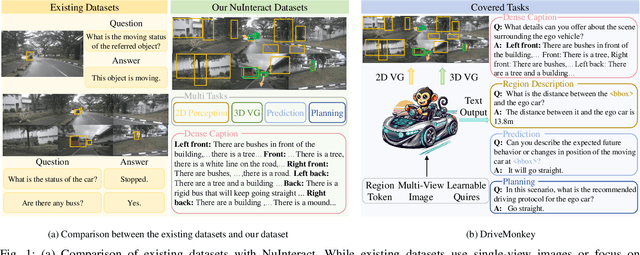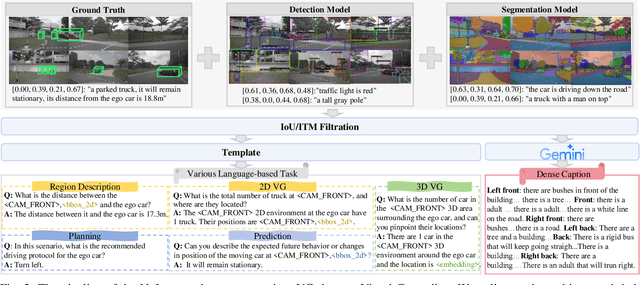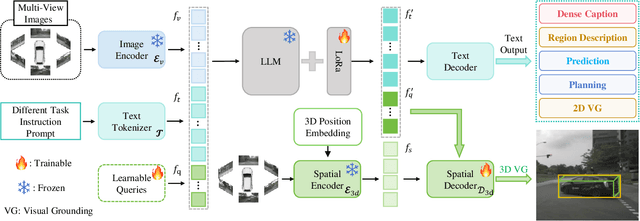Bing Wang
Rethinking Driving World Model as Synthetic Data Generator for Perception Tasks
Oct 22, 2025Abstract:Recent advancements in driving world models enable controllable generation of high-quality RGB videos or multimodal videos. Existing methods primarily focus on metrics related to generation quality and controllability. However, they often overlook the evaluation of downstream perception tasks, which are $\mathbf{really\ crucial}$ for the performance of autonomous driving. Existing methods usually leverage a training strategy that first pretrains on synthetic data and finetunes on real data, resulting in twice the epochs compared to the baseline (real data only). When we double the epochs in the baseline, the benefit of synthetic data becomes negligible. To thoroughly demonstrate the benefit of synthetic data, we introduce Dream4Drive, a novel synthetic data generation framework designed for enhancing the downstream perception tasks. Dream4Drive first decomposes the input video into several 3D-aware guidance maps and subsequently renders the 3D assets onto these guidance maps. Finally, the driving world model is fine-tuned to produce the edited, multi-view photorealistic videos, which can be used to train the downstream perception models. Dream4Drive enables unprecedented flexibility in generating multi-view corner cases at scale, significantly boosting corner case perception in autonomous driving. To facilitate future research, we also contribute a large-scale 3D asset dataset named DriveObj3D, covering the typical categories in driving scenarios and enabling diverse 3D-aware video editing. We conduct comprehensive experiments to show that Dream4Drive can effectively boost the performance of downstream perception models under various training epochs. Project: $\href{https://wm-research.github.io/Dream4Drive/}{this\ https\ URL}$
Pixel-Perfect Depth with Semantics-Prompted Diffusion Transformers
Oct 08, 2025



Abstract:This paper presents Pixel-Perfect Depth, a monocular depth estimation model based on pixel-space diffusion generation that produces high-quality, flying-pixel-free point clouds from estimated depth maps. Current generative depth estimation models fine-tune Stable Diffusion and achieve impressive performance. However, they require a VAE to compress depth maps into latent space, which inevitably introduces \textit{flying pixels} at edges and details. Our model addresses this challenge by directly performing diffusion generation in the pixel space, avoiding VAE-induced artifacts. To overcome the high complexity associated with pixel-space generation, we introduce two novel designs: 1) Semantics-Prompted Diffusion Transformers (SP-DiT), which incorporate semantic representations from vision foundation models into DiT to prompt the diffusion process, thereby preserving global semantic consistency while enhancing fine-grained visual details; and 2) Cascade DiT Design that progressively increases the number of tokens to further enhance efficiency and accuracy. Our model achieves the best performance among all published generative models across five benchmarks, and significantly outperforms all other models in edge-aware point cloud evaluation.
DiGS: Accurate and Complete Surface Reconstruction from 3D Gaussians via Direct SDF Learning
Sep 09, 2025Abstract:3D Gaussian Splatting (3DGS) has recently emerged as a powerful paradigm for photorealistic view synthesis, representing scenes with spatially distributed Gaussian primitives. While highly effective for rendering, achieving accurate and complete surface reconstruction remains challenging due to the unstructured nature of the representation and the absence of explicit geometric supervision. In this work, we propose DiGS, a unified framework that embeds Signed Distance Field (SDF) learning directly into the 3DGS pipeline, thereby enforcing strong and interpretable surface priors. By associating each Gaussian with a learnable SDF value, DiGS explicitly aligns primitives with underlying geometry and improves cross-view consistency. To further ensure dense and coherent coverage, we design a geometry-guided grid growth strategy that adaptively distributes Gaussians along geometry-consistent regions under a multi-scale hierarchy. Extensive experiments on standard benchmarks, including DTU, Mip-NeRF 360, and Tanks& Temples, demonstrate that DiGS consistently improves reconstruction accuracy and completeness while retaining high rendering fidelity.
ReCogDrive: A Reinforced Cognitive Framework for End-to-End Autonomous Driving
Jun 09, 2025Abstract:Although end-to-end autonomous driving has made remarkable progress, its performance degrades significantly in rare and long-tail scenarios. Recent approaches attempt to address this challenge by leveraging the rich world knowledge of Vision-Language Models (VLMs), but these methods suffer from several limitations: (1) a significant domain gap between the pre-training data of VLMs and real-world driving data, (2) a dimensionality mismatch between the discrete language space and the continuous action space, and (3) imitation learning tends to capture the average behavior present in the dataset, which may be suboptimal even dangerous. In this paper, we propose ReCogDrive, an autonomous driving system that integrates VLMs with diffusion planner, which adopts a three-stage paradigm for training. In the first stage, we use a large-scale driving question-answering datasets to train the VLMs, mitigating the domain discrepancy between generic content and real-world driving scenarios. In the second stage, we employ a diffusion-based planner to perform imitation learning, mapping representations from the latent language space to continuous driving actions. Finally, we fine-tune the diffusion planner using reinforcement learning with NAVSIM non-reactive simulator, enabling the model to generate safer, more human-like driving trajectories. We evaluate our approach on the planning-oriented NAVSIM benchmark, achieving a PDMS of 89.6 and setting a new state-of-the-art that surpasses the previous vision-only SOTA by 5.6 PDMS.
Genesis: Multimodal Driving Scene Generation with Spatio-Temporal and Cross-Modal Consistency
Jun 09, 2025Abstract:We present Genesis, a unified framework for joint generation of multi-view driving videos and LiDAR sequences with spatio-temporal and cross-modal consistency. Genesis employs a two-stage architecture that integrates a DiT-based video diffusion model with 3D-VAE encoding, and a BEV-aware LiDAR generator with NeRF-based rendering and adaptive sampling. Both modalities are directly coupled through a shared latent space, enabling coherent evolution across visual and geometric domains. To guide the generation with structured semantics, we introduce DataCrafter, a captioning module built on vision-language models that provides scene-level and instance-level supervision. Extensive experiments on the nuScenes benchmark demonstrate that Genesis achieves state-of-the-art performance across video and LiDAR metrics (FVD 16.95, FID 4.24, Chamfer 0.611), and benefits downstream tasks including segmentation and 3D detection, validating the semantic fidelity and practical utility of the generated data.
Dual-view Spatio-Temporal Feature Fusion with CNN-Transformer Hybrid Network for Chinese Isolated Sign Language Recognition
Jun 08, 2025Abstract:Due to the emergence of many sign language datasets, isolated sign language recognition (ISLR) has made significant progress in recent years. In addition, the development of various advanced deep neural networks is another reason for this breakthrough. However, challenges remain in applying the technique in the real world. First, existing sign language datasets do not cover the whole sign vocabulary. Second, most of the sign language datasets provide only single view RGB videos, which makes it difficult to handle hand occlusions when performing ISLR. To fill this gap, this paper presents a dual-view sign language dataset for ISLR named NationalCSL-DP, which fully covers the Chinese national sign language vocabulary. The dataset consists of 134140 sign videos recorded by ten signers with respect to two vertical views, namely, the front side and the left side. Furthermore, a CNN transformer network is also proposed as a strong baseline and an extremely simple but effective fusion strategy for prediction. Extensive experiments were conducted to prove the effectiveness of the datasets as well as the baseline. The results show that the proposed fusion strategy can significantly increase the performance of the ISLR, but it is not easy for the sequence-to-sequence model, regardless of whether the early-fusion or late-fusion strategy is applied, to learn the complementary features from the sign videos of two vertical views.
Extending Large Vision-Language Model for Diverse Interactive Tasks in Autonomous Driving
May 13, 2025



Abstract:The Large Visual-Language Models (LVLMs) have significantly advanced image understanding. Their comprehension and reasoning capabilities enable promising applications in autonomous driving scenarios. However, existing research typically focuses on front-view perspectives and partial objects within scenes, struggling to achieve comprehensive scene understanding. Meanwhile, existing LVLMs suffer from the lack of mapping relationship between 2D and 3D and insufficient integration of 3D object localization and instruction understanding. To tackle these limitations, we first introduce NuInteract, a large-scale dataset with over 1.5M multi-view image language pairs spanning dense scene captions and diverse interactive tasks. Furthermore, we propose DriveMonkey, a simple yet effective framework that seamlessly integrates LVLMs with a spatial processor using a series of learnable queries. The spatial processor, designed as a plug-and-play component, can be initialized with pre-trained 3D detectors to improve 3D perception. Our experiments show that DriveMonkey outperforms general LVLMs, especially achieving a 9.86% notable improvement on the 3D visual grounding task. The dataset and code will be released at https://github.com/zc-zhao/DriveMonkey.
Robust Misinformation Detection by Visiting Potential Commonsense Conflict
Apr 30, 2025



Abstract:The development of Internet technology has led to an increased prevalence of misinformation, causing severe negative effects across diverse domains. To mitigate this challenge, Misinformation Detection (MD), aiming to detect online misinformation automatically, emerges as a rapidly growing research topic in the community. In this paper, we propose a novel plug-and-play augmentation method for the MD task, namely Misinformation Detection with Potential Commonsense Conflict (MD-PCC). We take inspiration from the prior studies indicating that fake articles are more likely to involve commonsense conflict. Accordingly, we construct commonsense expressions for articles, serving to express potential commonsense conflicts inferred by the difference between extracted commonsense triplet and golden ones inferred by the well-established commonsense reasoning tool COMET. These expressions are then specified for each article as augmentation. Any specific MD methods can be then trained on those commonsense-augmented articles. Besides, we also collect a novel commonsense-oriented dataset named CoMis, whose all fake articles are caused by commonsense conflict. We integrate MD-PCC with various existing MD backbones and compare them across both 4 public benchmark datasets and CoMis. Empirical results demonstrate that MD-PCC can consistently outperform the existing MD baselines.
NormalCrafter: Learning Temporally Consistent Normals from Video Diffusion Priors
Apr 15, 2025



Abstract:Surface normal estimation serves as a cornerstone for a spectrum of computer vision applications. While numerous efforts have been devoted to static image scenarios, ensuring temporal coherence in video-based normal estimation remains a formidable challenge. Instead of merely augmenting existing methods with temporal components, we present NormalCrafter to leverage the inherent temporal priors of video diffusion models. To secure high-fidelity normal estimation across sequences, we propose Semantic Feature Regularization (SFR), which aligns diffusion features with semantic cues, encouraging the model to concentrate on the intrinsic semantics of the scene. Moreover, we introduce a two-stage training protocol that leverages both latent and pixel space learning to preserve spatial accuracy while maintaining long temporal context. Extensive evaluations demonstrate the efficacy of our method, showcasing a superior performance in generating temporally consistent normal sequences with intricate details from diverse videos.
Collaboration and Controversy Among Experts: Rumor Early Detection by Tuning a Comment Generator
Apr 05, 2025Abstract:Over the past decade, social media platforms have been key in spreading rumors, leading to significant negative impacts. To counter this, the community has developed various Rumor Detection (RD) algorithms to automatically identify them using user comments as evidence. However, these RD methods often fail in the early stages of rumor propagation when only limited user comments are available, leading the community to focus on a more challenging topic named Rumor Early Detection (RED). Typically, existing RED methods learn from limited semantics in early comments. However, our preliminary experiment reveals that the RED models always perform best when the number of training and test comments is consistent and extensive. This inspires us to address the RED issue by generating more human-like comments to support this hypothesis. To implement this idea, we tune a comment generator by simulating expert collaboration and controversy and propose a new RED framework named CAMERED. Specifically, we integrate a mixture-of-expert structure into a generative language model and present a novel routing network for expert collaboration. Additionally, we synthesize a knowledgeable dataset and design an adversarial learning strategy to align the style of generated comments with real-world comments. We further integrate generated and original comments with a mutual controversy fusion module. Experimental results show that CAMERED outperforms state-of-the-art RED baseline models and generation methods, demonstrating its effectiveness.
 Add to Chrome
Add to Chrome Add to Firefox
Add to Firefox Add to Edge
Add to Edge